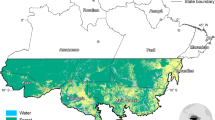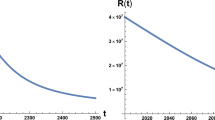Abstract
Deforestation in the Brazilian Amazon was less than 1% before 1975. Between 1975 and 1987 the rate increased exponentially. By 1985, world opinion and attention to the destruction of the richest biome on earth led to elimination of some of the major incentives that had fueled deforestation. Favorable credit policies for cattle ranchers, rather than population growth, explains the process of deforestation in the Brazilian Amazon. The paper suggests other actions that may be taken to reduce deforestation, and examines the rapid growth rates of secondary successional species in a colonization area.
Similar content being viewed by others
References
Aber, J., and Melillo, J. (1991).Terrestrial Ecosystems. Saunders, Philadelphia.
Anderson, J. (1990). Rainforest Destruction: Construction of a Media Issue. Unpublished paper, Indiana University School of Journalism.
Andreae, M., and Schimel, D. (eds.) (1989).Exchange of Trace Gases between Terrestrial Ecosystems and the Atmosphere. Wiley-Interscience, New York.
Bedoya, E. (1989). Deforestation and Land Degradation in the Peruvian Upper Jungle. Paper presented at 88th Annual Meeting of the American Anthropological Association, Washington, D.C., November 18.
Booth, W. (1989). Monitoring the fate of the forests from space.Science 243: 1428–1429.
Browder, J. (1986). Logging the Rainforest: A Political Economy of Timber Extraction and Unequal Exchange in the Brazilian Amazon. Ph.D. dissertation, University of Pennsylvania.
Browder, J. (1988). Public policy and deforestation in the Brazilian Amazon. In Repetto, R., and Gillis, M. (eds.),Public Policies and the Misuse of Forest Resources. World Resources Institute and Cambridge University Press, Washington, D.C.
Bunker, S. (1980). The impact of deforestation on peasant communities in the Medio Amazonas of Brazil.Studies in Third World Societies 13: 45–60.
Collins, M., Sayer, J., and Whitmore, T. (1991).The Conservation Atlas of Tropical Forests: Asia and the Pacific. Simon and Schuster, New York.
Crutzen, P., and Andreae, (1990). Biomass burning in the tropics: Impacts on atmospheric chemistry and biogeochemical cycles.Science 250: 1669–1678.
Dale, V., Houghton, R., and Hall, C. (1991). Estimating the effects of land use change on global atmospheric carbon dioxide.Canadian Journal of Forestry Research 21: 87–90.
Denevan, W. (1980). Swidden and cattle versus forest: The imminent demise of the Amazon rain forest reexamined.Studies in Third World Societies 13: 25–44.
Denevan, W., and Padoch, C. (eds.) (1988).Swidden Fallow Agroforestry in the Peruvian Amazon. New York Botanical Garden, Monograph Series in Economic Botany, New York.
Detwiler, R., and Hall, C. (1988). Tropical forests and the global carbon cycle.Science 239: 42–47.
Dickinson, R. (ed.) (1987).The Geophysiology of Amazonia. Wiley, New York.
Fearnside, P. (1982). Deforestation in the Brazilian Amazon: How fast is it occurring?Interciencia 7(2): 82–88.
Fearnside, P. (1987a). Causes of deforestation in the Brazilian Amazon. In Dickinson, R. E. (ed.),The Geophysiology of Amazonia: Vegetation and Climate Interactions. Wiley and United Nations University, New York, pp. 37–61.
Fearnside, P. (1987b). Deforestation and international economic development projects in Brazilian Amazonia.Conservation Biology 1(3): 214–221.
Ferreira Reis, A. (1968).A Amazonia e a Cobiça Internacional. Gráfica Record Editôra, Río de Janeiro.
Gama ne Silva, R. (1991).Olho Grande na Amazônia Brasileira. Editôra Rio Fundo, Río de Janeiro.
Gillis, M. (1988). The logging industry in tropical Asia. In Denslow, J., and Padoch, C. (eds.),People of the Tropical Rain Forest. University of California Press, Berkeley.
Goldemberg, J. (1989). Introduction.Amazonia: Facts, Problems and Solutions. Fundaçāo da Universidade de Sāo Paulo and INPE, Sāo Paulo.
Gomez-Pompa, A., Vazquez-Yanes, C., and Guevara, S. (1972). The tropical rain forest: A non-renewable resource.Science 177: 762–765.
Hames, R., and Vickers, W. (eds.) (1983).Adaptive Responses of Native Amazonians. Academic Press, New York.
Hecht, S. (1980). Deforestation in the Amazon Basin: Magnitude, dynamics and soil resource effects.Studies in Third World Societies 13: 61–108.
Hecht, S. (1983). Cattle ranching in the eastern Amazon: Environmental and social implications. In Moran, E. F. (ed.),The Dilemma of Amazonian Development. Westview Press, Boulder.
Hecht, S., and Cockburn, A. (1989).The Fate of the Forest. Verso, London.
Hecht, S., Norgaard, R., and Possio, G. (1988). The economics of cattle ranching in eastern Amazonia.Interciencia 13(5): 233–240.
Hemming, J. (ed.) (1985).Change in the Amazon Basin (2 Vols.). Manchester University Press, Manchester.
Henderson-Sellers, A. (1987). Effect of change in land use on climate in the humid tropics. In Dickinson, R. (ed.),The Geophysiology of Amazonia. Wiley, New York.
Hirsch, P. (1987). Deforestation and development in Thailand.Singapore Journal of Tropical Geography 8: 129–138.
Houghton, R. A. (1992). The Extent of Land Use Change, Worldwide. Paper presented at 1992 Meeting of the Ecological Society of America, Honolulu, Hawaii.
Janzen, D. (1988). Carbon dioxide reduction and reforestation.Science 242: 132.
Kleinpenning, J. M. G. (1975).The Integration and Colonization of the Brazilian Portion of the Amazon Basin. Institute of Geography and Planning, Nijmegen, Holland.
Kummer, D. M. (1992).Deforestation in the Postwar Philippines. University of Chicago Press, Chicago.
Kummer, D., and Turner, B. L., II (1992). Fundamental Causes of Land Use Change: An Exploratory Attempt at Generalization Across Space. Paper presented at Land Use Change Symposium, Ecological Society of America Annual Meeting, Honolulu, Hawaii.
Lean, J., and Warrilow, D. (1989). Simulation of the regional climate impact of Amazon deforestation.Nature 342: 411–412.
Mahar, D. (1979).Frontier Development Policy in Brazil: A Study of Amazonia. Praeger, New York.
Mahar, D. (1988).Government Policies and Deforestation in Brazil's Amazon Region. World Bank, Washington, D.C.
Molion, L. (1987). Micrometereology of an Amazonian rain forest. In Dickinson, R. (ed.),The Geophysiology of Amazonia. Wiley, New York.
Moran, E. F. (1976).Agricultural Development Along the Transamazon Highway. Center for Latin American Studies Monograph Series, Bloomington, Indiana University.
Moran, E. F. (1981).Developing the Amazon. Indiana University Press, Bloomington.
Moran, E. F. (ed.) (1983).The Dilemma of Amazonian Development. Westview Press, Boulder.
Moran, E. F. (1990).A Ecología Humana das Populaçōes da Amazônia. Editôra Vozes, Petrópolis (Brazil); English edition, Through Amazonian Eyes. University of Iowa Press, 1993.
Moran, E. F., Brondízio, E., Mausel, P., and Wu, Y. (in press). Deforestation in Amazonia: Ground and Satellite-Level Perspectives.BioScience.
Moran, E. F., Brondízio, E., and Dantas, M. (1993). Secondary succession in a eutrophic tropical moist forest (submitted toBiotropica).
Mougeot, L., and Aragon, L. (eds.) (1981).O Despovoamento do Território Amazônico. Cadernos do NAEA, University Federal do Pará, Belém.
Myers, N. (1984).The Primary Source: Topical Forests and Our Future. Norton, New York.
National Research Council (1982).Ecological Aspects of Development in the Humid Tropics. National Academy Press, Washington, D.C.
Posey, D., and Balée, W. (eds.) (1989).Resource Management in Amazonia: Indigenous and Folk Strategies. New York Botanical Garden, Advances in Economic Botany Monograph Number 7, New York.
Prance, G. T., and Lovejoy, T. (eds.) (1985).Key Environments: Amazonia. Pergamon, London.
Repetto, R. (1988).The Forest for the Trees? Government Policies and the Misuse of Forest Resources. World Resources Institute, Washington, D.C.
Repetto, R., and Gillis, M. (eds.) (1988).Public Policies and the Misuse of Forest Resources. Cambridge University Press and World Resources Institute, New York.
Salati, E. (1985). The climatology and hydrology of Amazonia. In Prance, G., and Lovejoy, T. (eds.),Key Environments: Amazonia. Pergamon Press, London, pp. 18–48.
Salati, E., and Vose, P. B. (1984). Amazon basin: A system in equilibrium.Science 225: 129–138.
Scudder, T. (1981).The Development of New Lands Settlement in the Tropics and Subtropics: A Global State-of-the-Art Evaluation with Specific Emphasis on Policy Implications. Institute for Development Anthropology, Binghamton.
Setzer, A., and Pereira, M. (1991). Amazonian biomass burnings in 1987 and an estimate of their tropospheric emissions.Ambio 20: 19–22.
Shukla, J., Nobre, C., and Sellers, P. (1990). Amazon deforestation and climate change.Science 247: 1322–1325.
Silver, C. S. (1990).One Earth, One Future: Our Changing Global Environment. National Academy Press, Washington, D.C.
Smith, N. (1982).Rainforest Corridors. University of California Press, Berkeley.
Stern, P., Young, O., and Druckman, D. (eds.) (1992).Global Environmental Change: Understanding the Human Dimensions, National Academy Press, Washington, D.C.
Treece, D. (1989). The militarization and industrialization of Amazonia.The Ecologist 19: 225–228.
Tucker, C. J., Holben, B., and Goff, T. (1984). Intensive forest clearing in Rondonia, Brazil, as detected by satellite remote sensing.Remote Sensing and the Environment 15: 255–261.
Uhl, C., and Buschbacher, R. (1985). A disturbing synergism between cattle ranch burning practices and selective tree harvesting in the Eastern Amazon.Biotropica 17: 265–268.
Uhl, C., and Jordan, C. (1984). Succession and nutrient dynamics following forest cutring and burning.Ecology 65: 1476–1490.
Uhl, C., and Vieira, I. C. G. (1989). Ecological impacts of selective logging in the Brazilian Amazon: A case study from the Paragominas Region in the state of Para.Biotropica 21: 98–106.
Uhl, C., Clark, K., and Maquirino, P. (1982). Successional patterns associated with slash-and-burn agriculture in the Upper Rio Negro region of the Amazon Basin.Biotropica 14: 249–254.
Uhl, C., Buschbacher, R., and Serrāo, E. A. S. (1988). Abandoned pastures in eastern Amazonia. I. Patterns of plant succession.Journal of Ecology 73: 663–681.
Vásquez, G., and YoKomizo, Y. (1986). Resultados de 20 anos de incentivos fiscais na agropecuária de Amazônia.XVI Encontro Nacional De Economia 2: 47–84.
Whittaker, R., and Marks, P. (1975). The biosphere and man. In Leith, H., and Whittaker, R. (eds.),Primary Productivity of the Biosphere. Springer-Verlag, Berlin.
Wilson, E. O. (ed.) (1988).Biodiversity. National Academy Press, Washington, D.C.
Woodwell, G. M., Houghton, R. A., Stone, T. A., and Park, A. B. (1986a). Changes in the areas of forests in Rondonia, Amazon Basin, measured by satellite imagery. In Trabalka, J., and Reichle, D. (eds.),The Changing Carbon Cycle: A Global Analysis. Springer-Verlag, New York, pp. 242–257.
Woodwell, G. M., Houghton, R. A., and Stone, T. A. (1986b). Deforestation in the Brazilian Amazon Basin measured by satellite imagery. In Prance, G. T. (ed.),Tropical Rain Forests and the World Atmosphere. American Association for the Advancement of Science, Selected Symposium 101, Washington, D.C.
Author information
Authors and Affiliations
Rights and permissions
About this article
Cite this article
Moran, E.F. Deforestation and land use in the Brazilian Amazon. Hum Ecol 21, 1–21 (1993). https://doi.org/10.1007/BF00890069
Issue Date:
DOI: https://doi.org/10.1007/BF00890069




